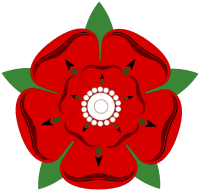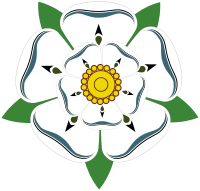John of Gaunt, 1st Duke of Lancaster
| John of Gaunt | |
|---|---|
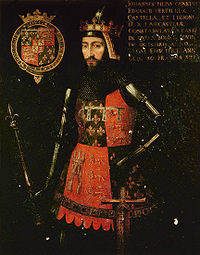 |
|
|
|
|
| Successor | Henry IV Bolingbroke, King of England (2nd Duke of Lancaster and of Aquitaine) |
| Spouse | Blanche of Lancaster m. 1359; dec. 1369 Infanta Constance of Castile m. 1371; dec. 1394 Katherine Swynford m. 1396; wid. 1399 |
| Issue | |
| Philippa, Queen of Portugal Elizabeth Plantagenet, Duchess of Exeter Henry IV Bolingbroke, King of England Katherine, Queen of Castile John Beaufort, 1st Earl of Somerset Cardinal Henry Beaufort Thomas Beaufort, Duke of Exeter Joan Beaufort, Countess of Westmorland |
|
| House | House of Plantagenet |
| Father | Edward III of Windsor, King of England |
| Mother | Philippa of Hainault |
| Born | 6 March 1340 Ghent, Belgium |
| Died | 3 February 1399 (aged 58) Leicester Castle, Leicestershire |
| Burial | St Paul's Cathedral, City of London |
John of Gaunt, 1st Duke of Lancaster, 5th Earl of Leicester, 2nd Earl of Derby, Duke of Aquitaine, KG (6 March 1340 – 3 February 1399) was a member of the House of Plantagenet, the third surviving son of King Edward III of England and Philippa of Hainault. He was called "John of Gaunt" because he was born in Ghent (in modern Belgium), Gaunt in English.
John exercised great influence over the English throne during the minority of his nephew, Richard II, and during the ensuing periods of political strife, but was not thought to have been among the opponents of the King.
John of Gaunt's legitimate male heirs, the Lancasters (the other party in the Wars of the Roses, the Yorks, being the male descendants of his younger brother, Edmund), included Kings Henry IV, Henry V, and Henry VI. His other legitimate descendants included his daughters Philippa of Lancaster, Queen consort of John I of Portugal and mother of King Duarte of Portugal and Elizabeth, Duchess of Exeter, mother of John Holland, 2nd Duke of Exeter through his first wife, Blanche; and by his second wife, Constance, John was father of Katherine of Lancaster, Queen consort of Henry III of Castile, granddaughter of Peter of Castile and mother of John II of Castile. John fathered five children outside marriage, one early in life by a lady-in-waiting to his mother, and four surnamed "Beaufort", by Katherine Swynford, Gaunt's long-term mistress and third wife. The Beaufort children, three sons and a daughter, were legitimized by royal and papal decrees after John and Katherine married in 1396. Descendants of this marriage included Henry Beaufort, Bishop of Winchester and eventually Cardinal; Joan Beaufort, Countess of Westmorland, grandmother of Kings Edward IV and Richard III; and John Beaufort, 1st Earl of Somerset.
When John died in 1399, his estates were declared forfeit as King Richard II had exiled John's son and heir, Henry Bolingbroke, in 1398. Bolingbroke returned from exile to reclaim his inheritance and deposed Richard. Bolingbroke then reigned as King Henry IV of England (1399–1413), the first of the descendants of John of Gaunt to hold the throne of England.
John of Gaunt was buried beside his first wife, Blanche of Lancaster, in the nave of Old St. Paul's Cathedral in an alabaster tomb designed by Henry Yevele (similar to that of his son in Canterbury Cathedral).
Contents |
Duke of Lancaster
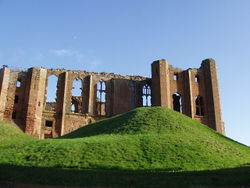
John of Gaunt's first wife, Blanche, was also his third cousin, both being great-grandchildren of King Henry III. They married in 1359 at Reading Abbey as King Edward III arranged matches for his sons with wealthy heiresses. Upon the death of his father-in-law in 1361, John received half of Henry's lands, the title Earl of Lancaster, and the distinction as the greatest landowner in the north of England, inheriting the Palatinate of Lancaster. He also became the 14th Baron of Halton. John inherited the rest when Blanche's sister, Maud, Countess of Leicester (married to William V, Count of Hainaut), died on 10 April 1362. John received the title "Duke of Lancaster" from his father on 13 November 1362. John was by then well established, owning at least thirty castles and estates across England and France. His household was comparable in scale and organization to that of a monarch.
After the death of his older brother Edward of Woodstock, (also known as The Black Prince), John of Gaunt contrived to protect the religious reformer John Wyclif, possibly to counteract the growing secular power of the Roman Catholic Church. However, John's ascendancy to political power coincided with widespread resentment of his influence. At a time when English forces encountered setbacks in the Hundred Years' War against France, and Edward III's rule was becoming unpopular due to high taxation and his affair with Alice Perrers, political opinion closely associated the Duke of Lancaster with the failing government of the 1370s. Furthermore, while King Edward and the Prince of Wales were popular heroes due to their successes on the battlefield, John of Gaunt had not won equivalent military renown that could have bolstered his reputation. Although he fought in the Battle of Nájera, for example, his later military projects were unsuccessful.
On his marriage to Infanta Constance of Castile in 1371, John assumed the title of King of Castile and Leon, and insisted his fellow English nobles henceforth address him as 'my lord of Spain.'
When King Edward III died in 1377 and John's ten-year-old nephew succeeded as Richard II of England, John's influence strengthened. However, mistrust remained, and some suspected him of wanting to seize the throne himself. John took pains to ensure that he never became associated with the opposition to Richard's kingship. As virtual ruler during Richard's minority, he made unwise decisions on taxation that led to the Peasants' Revolt in 1381, when the rebels destroyed his Savoy Palace in London.
In 1386, John left England to claim the throne of Castile. However, crisis ensued almost immediately, and in 1387, King Richard's misrule brought England to the brink of civil war. Only John, on his return to England in 1389, was able to persuade the Lords Appellant and King Richard to compromise, ushering in a period of relative stability. During the 1390s, John's reputation of devotion to the well-being of the kingdom was largely restored. John died of natural causes on 3 February 1399 at Leicester Castle, with his third wife, Katherine, by his side.
Marriages and descendants
- John's first child was an illegitimate daughter known as Blanche Plantagenet (1359-1388/89). Blanche was the daughter of John's mistress Marie de St. Hilaire of Hainaut (1340-after 1399), who was a lady in waiting to his mother, Queen Philippa. The affair apparently took place before John's first marriage, which was to his cousin Blanche of Lancaster. John's daughter, Blanche Plantagenet, married Sir Thomas Morieux in 1381. Morieux held several important posts, including Constable of the Tower the year he was married, and Master of Horse to King Richard II two years later. He died in 1387 after six years of marriage. Blanche Plantagenet Morieux was not included in the decree which legitimated John's children by Katherine Swynford in 1396.[1][2][3]
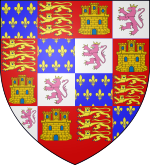
- On 19 May 1359 at Reading Abbey, John married his third cousin, Blanche of Lancaster, daughter of Henry of Grosmont, 1st Duke of Lancaster. The wealth she brought to the marriage was the foundation of John's fortune. Blanche died of bubonic plague on 12 September 1369 at Bolingbroke Castle, while her husband was away at sea. Their son Henry Bolingbroke became Henry IV of England. Their daughter Philippa became Queen of Portugal by marrying King John I of Portugal in 1387.
- In 1371, John married Infanta Constance of Castile, daughter of King Peter of Castile, thus giving him a claim to the Crown of Castile, which he would pursue. Though John was never able to make good his claim, his daughter by Constance, Katherine of Lancaster, became Queen of Castile by marrying Henry III of Castile.
- During his marriage to Constance, John of Gaunt had fathered four children by a mistress, the widow Katherine Swynford (whose sister Philippa de Roet was married to Chaucer). Prior to her widowhood, Katherine had borne at least two, possibly three, children to Lancastrian knight Sir Hugh Swynford. The known names of these children are Blanche and Thomas. (There may have been a second Swynford daughter.) John of Gaunt was Blanche Swynford's godfather.[3]
Constance died in 1394. John married Katherine in 1396, and their children, the Beauforts, were legitimised by King Richard II and the Church, but barred from inheriting the throne. From the eldest son, John, descended a granddaughter, Margaret Beaufort, whose son, later King Henry VII of England, would nevertheless claim the throne.
All monarchs of England and later of Great Britain, the United Kingdom and the Commonwealth Realms from Henry IV onwards are descended from John of Gaunt.
Children
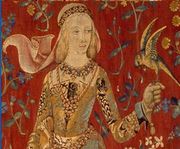

- By Marie de St. Hilaire of Hainaut, mistress:
- Blanche Plantagenet (1359–1388/89), married Sir Thomas Morieux (1355–1387) in 1381
- By Blanche of Lancaster:
- Philippa (1360–1415), married King John I of Portugal (1357–1433)
- John (1362–1365); Buried Church of St Mary de Castro, Leicester
- Elizabeth (1364–1426), married (1) in 1380 John Hastings, 3rd Earl of Pembroke (1372–1389), annulled 1383; married (2) in 1386 John Holland, 1st Duke of Exeter (1350–1400); (3) Sir John Cornwall, 1st Baron Fanhope and Milbroke (d. 1443)
- Edward (1365–1368); Buried Church of St Mary de Castro, Leicester
- John (1366–1367); Buried Church of St Mary de Castro, Leicester
- Henry IV of England (1366–1413), married (1) Mary de Bohun (1369–1394); (2) Joanna of Navarre (1368–1437)
- Isabel (1368–1368)[4] [5]
- By Constance of Castile:
- By Katherine Swynford (née de Roet/Roelt), mistress and later wife (children legitimised 1397):
- John Beaufort, 1st Earl of Somerset (1373–1410) – married Margaret Holland.
- Henry Beaufort, Bishop of Winchester and Cardinal (1375–1447)
- Thomas Beaufort, Duke of Exeter (1377–1427), married Margaret Neville.
- Joan Beaufort (1379–1440) – married first Robert Ferrers, 3rd Baron Ferrers of Wemme and second Ralph Neville, 1st Earl of Westmoreland.
Relationship to Chaucer
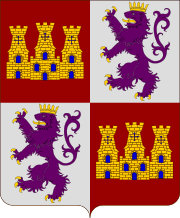
John of Gaunt was a patron of the poet Geoffrey Chaucer who recorded much of the mores of England at the time of John in The Canterbury Tales. Near the end of John's life, they were brothers-in-law. Chaucer was married to Philippa de Roet; John's third wife, Katherine, was Philippa's sister. John's children by Katherine were Chaucer's nieces and nephews.
Chaucer's Book of the Duchess, also known as The Deth of Blaunche, was written in commemoration of Blanche of Lancaster, John's first wife. The poem refers to John and Blanche in allegory as the "Black Knight" and the "Lady White." "Blanche" means "white." At the end of the poem reference is made to John's marriage to Blanche by playing on the sound of their titles of Lancaster and Richmond in the form of "long castel" (line 1318) and "riche hil" (line 1319).
Some have suggested that the "long castel" line could also refer to Constanza of Castile, John's second wife, and the heraldic arms of Castile, which display a castle, part of the tradition of heraldic canting arms.
Titles, styles, arms and honours
Arms
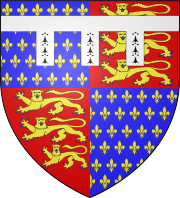
As a son of the sovereign, John bore the arms of the kingdom, differentiated by a label argent of three points ermine.[8]
Popular culture
The Lancaster city centre has a public house called The John O'Gaunt. An administrative ward on the city council also bears the name.
Hungerford in Berkshire also has ancient links to the Duchy, the manor becoming part of John of Gaunt's estate in 1362 before James I passed ownership to two local men in 1612 (which subsequently became Hungerford Town & Manor). The links are visible today in the Town and Manor-owned John O'Gaunt pub, the John O'Gaunt state secondary school, as well as various street names. It is also customary for the Loyal Toast to be given by residents as "The Queen, the Duke of Lancaster." There is also a secondary school in Trowbridge, Wiltshire bearing the same name, which is built upon land that he once owned.
John held large tracts of land in Lincolnshire and the City of Lincoln. At the appropriately named site of Gaunt Street, he maintained a palace, remains of which were found in the late 60's. A Finial window, complete, was found between two walls in the then 'West's Garage'. This was moved and now adorns the entrance through the East bail of Lincoln castle.
Opposite the Palace site, stands St.Mary's Guildhall, locally known as John O'Gaunt's stables. This large medieval building, once formed the entrance to the Football ground of Lincoln City F.C., until they moved to their present ground. It was known as The John O'Gaunt ground.
The remnants of the castle at Newcastle-under-Lyme, Staffordshire, once owned by John, sit on John o' Gaunt's Street.
The John of Gaunt Stakes is a British race for Thoroughbred horses run annually in June.
In William Shakespeare's play Richard II, the famous England speech is attributed to John of Gaunt as he lay on his deathbed.
- This royal throne of kings, this scepter'd isle,
- This earth of majesty, this seat of Mars,
- This other Eden, demi-paradise,
- This fortress built by Nature for herself
- Against infection and the hand of war,
- This happy breed of men, this little world,
- This precious stone set in the silver sea,
- Which serves it in the office of a wall,
- Or as a moat defensive to a house,
- Against the envy of less happier lands,
- This blessed plot, this earth, this realm, this England,
- This nurse, this teeming womb of royal kings,
- Fear'd by their breed and famous by their birth
- Renowned for their deeds as far from home,
- For Christian service and true chivalry,
- As is the sepulchre in stubborn Jewry,
- Of the world's ransom, blessed Mary's Son,
- This land of such dear souls, this dear dear land,
- Dear for her reputation through the world,
- Is now leased out, I die pronouncing it,
- Like to a tenement or pelting farm:
- England, bound in with the triumphant sea
- Whose rocky shore beats back the envious siege
- Of watery Neptune, is now bound in with shame,
- With inky blots and rotten parchment bonds:
- That England, that was wont to conquer others,
- Hath made a shameful conquest of itself.
- Ah, would the scandal vanish with my life,
- How happy then were my ensuing death!
- —Act II, scene i, 42–54
The Tragedy of King Richard II at Wikisource
Anya Seton's bestselling 1954 novel Katherine depicts John's long-term affair and eventual marriage to Katherine Swynford.
The eponymous character of the US comic book series GrimJack is legally named John Gaunt. According to author John Ostrander, he took the name from the historical figure simply because it sounded impressive, without any specific historical reference.
John of Gaunt is a major character in Garry O'Connor's Chaucer’s Triumph: Including the Case of Cecilia Chaumpaigne, the Seduction of Katherine Swynford, the Murder of Her Husband, the Interment of John of Gaunt and Other Offices of the Flesh in the Year 1399.
The romance novel "Almost Innocent" by Jane Feather tells the story of a possibly fictitious illegitimate daughter of John of Gaunt, and contains much history and vivid description of John and of royal life.
John of Gaunt's armour has been on display in the Tower of London for many years, and is of exceptional size, since the man himself was 6'7" tall. However, in Alison Weir's biography of Katherine Swynford (2007), Weir states that this is legend and that the armor in question is of German origin, not English.
References
- ↑ Genealogics: John of Gaunt, genealogical record. Accessed 11 March 2008.
- ↑ Blanche Plantagenet, genealogical record at The Peerage website citing Alison Weir, Britain's Royal Family: A Complete Genealogy (London, U.K.: The Bodley Head, 1999), page 99. Accessed 11 March 2008.
- ↑ 3.0 3.1 Dame Blanche Morieux in John of Gaunt: King of Castile and Leon, Duke of Aquitaine and Lancaster by Sydney Armitage-Smith, pp. 460-461. (1904, 1905). Accessed 11 March 2008.
- ↑ Leese, Thelma Anna, Blood royal: issue of the kings and queens of medieval England, 1066-1399, (Heritage Books Inc., 1996), 219.
- ↑ G.E. Cokayne; with Vicary Gibbs, H.A. Doubleday, Geoffrey H. White, Duncan Warrand and Lord Howard de Walden, editors, The Complete Peerage of England, Scotland, Ireland, Great Britain and the United Kingdom, Extant, Extinct or Dormant, new ed, 13 volumes in 14 (1910-1959 reprint in 6 volumes, Gloucester, U.K. Alan Sutton Publishing, 2000), volume XII/2, page 908 Hereinafter cited as The Complete Peerage
- ↑ Leese, Thelma Anna, Blood royal: issue of the kings and queens of medieval England, 1066-1399, (Heritage Books Inc., 1996), 222.
- ↑ G.E. Cokayne; with Vicary Gibbs, H.A. Doubleday, Geoffrey H. White, Duncan Warrand and Lord Howard de Walden, editors, The Complete Peerage of England, Scotland, Ireland, Great Britain and the United Kingdom, Extant, Extinct or Dormant, new ed, 13 volumes in 14 (1910-1959 reprint in 6 volumes, Gloucester, U.K. Alan Sutton Publishing, 2000), volume XII/2, page 908 Hereinafter cited as The Complete Peerage
- ↑ Marks of Cadency in the British Royal Family
Further reading
- Armitage-Smith, Sydney (1904) John of Gaunt, King of Castile and Leon, Duke of Lancaster, &c. London: Constable
- Cantor, Norman F. (2004) The Last Knight: the Twilight of the Middle Ages and the Birth of the Modern Era New York: Free Press, 2004
- Goodman, Anthony (1992) John of Gaunt: the Exercise of Princely Power in Fourteenth-Century Europe. New York: St. Martin's Press
- Walker, Simon (1990) The Lancastrian Affinity, 1361–1399 Oxford: Clarendon Press
External links
- Information about John of Gaunt
- Tudor Place's John of Gaunt page
- RoyaList Online interactive family tree (en)
- Sir Jean Froissart:John of Gaunt in Portugal, 1385
Ancestry
| Ancestors of John of Gaunt, 1st Duke of Lancaster | ||||||||||||||||||||||||||||||||||||||||||||||||||||||||||||||||||||||||||||||||||||||||||||||||||||||||||||||||||||||||||||||||||||||||||||||||||||||||||||||||||||||||||||||||||||||||||||||||||||||||||||||||||||||||||||||||||||||||||||||||||||||||||||||||||||||||||||||||||||||||||||||||||||||||||||||||||||||||||||||||||||||||||||||||||||||||||||||||||||||||||||||||||||||||||||||||||||||||||||||||||||||||||||||||||||||||||||||||||||||||||||||||||||||||||||||||||||||||||||||||||||||||||||||||||||||||||||||||||||||||||||||||||||||||||||||||||
|---|---|---|---|---|---|---|---|---|---|---|---|---|---|---|---|---|---|---|---|---|---|---|---|---|---|---|---|---|---|---|---|---|---|---|---|---|---|---|---|---|---|---|---|---|---|---|---|---|---|---|---|---|---|---|---|---|---|---|---|---|---|---|---|---|---|---|---|---|---|---|---|---|---|---|---|---|---|---|---|---|---|---|---|---|---|---|---|---|---|---|---|---|---|---|---|---|---|---|---|---|---|---|---|---|---|---|---|---|---|---|---|---|---|---|---|---|---|---|---|---|---|---|---|---|---|---|---|---|---|---|---|---|---|---|---|---|---|---|---|---|---|---|---|---|---|---|---|---|---|---|---|---|---|---|---|---|---|---|---|---|---|---|---|---|---|---|---|---|---|---|---|---|---|---|---|---|---|---|---|---|---|---|---|---|---|---|---|---|---|---|---|---|---|---|---|---|---|---|---|---|---|---|---|---|---|---|---|---|---|---|---|---|---|---|---|---|---|---|---|---|---|---|---|---|---|---|---|---|---|---|---|---|---|---|---|---|---|---|---|---|---|---|---|---|---|---|---|---|---|---|---|---|---|---|---|---|---|---|---|---|---|---|---|---|---|---|---|---|---|---|---|---|---|---|---|---|---|---|---|---|---|---|---|---|---|---|---|---|---|---|---|---|---|---|---|---|---|---|---|---|---|---|---|---|---|---|---|---|---|---|---|---|---|---|---|---|---|---|---|---|---|---|---|---|---|---|---|---|---|---|---|---|---|---|---|---|---|---|---|---|---|---|---|---|---|---|---|---|---|---|---|---|---|---|---|---|---|---|---|---|---|---|---|---|---|---|---|---|---|---|---|---|---|---|---|---|---|---|---|---|---|---|---|---|---|---|---|---|---|---|---|---|---|---|---|---|---|---|---|---|---|---|---|---|---|---|---|---|---|---|---|---|---|---|---|---|---|---|---|---|---|---|---|---|---|---|---|---|---|---|---|---|---|---|---|---|---|---|---|---|---|---|---|---|---|---|---|---|---|---|---|---|---|---|---|---|---|---|---|---|---|---|---|---|---|---|---|---|---|---|---|---|---|---|---|---|---|---|---|---|---|---|---|---|---|---|---|---|---|---|---|---|---|---|---|---|---|---|---|---|---|---|---|---|---|---|---|---|---|---|---|---|---|---|---|---|---|---|---|---|---|---|---|---|---|---|---|---|---|---|---|---|---|---|---|---|---|---|---|---|---|---|---|---|---|---|
|
||||||||||||||||||||||||||||||||||||||||||||||||||||||||||||||||||||||||||||||||||||||||||||||||||||||||||||||||||||||||||||||||||||||||||||||||||||||||||||||||||||||||||||||||||||||||||||||||||||||||||||||||||||||||||||||||||||||||||||||||||||||||||||||||||||||||||||||||||||||||||||||||||||||||||||||||||||||||||||||||||||||||||||||||||||||||||||||||||||||||||||||||||||||||||||||||||||||||||||||||||||||||||||||||||||||||||||||||||||||||||||||||||||||||||||||||||||||||||||||||||||||||||||||||||||||||||||||||||||||||||||||||||||||||||||||||||
|
John of Gaunt
Born: 6 March 1340 Died: 3 February 1399 |
||
| Political offices | ||
|---|---|---|
| Preceded by Henry of Grosmont, 1st Duke of Lancaster |
Lord High Steward 1362–1399 |
Succeeded by Henry Bolingbroke, 2nd Duke of Lancaster |
| Peerage of England | ||
| New creation | Duke of Lancaster 1362–1399 |
Succeeded by Henry Bolingbroke, 2nd Duke of Lancaster and of Aquitaine, 6th Earl of Leicester and of Lancaster, 3rd Earl of Derby |
| Preceded by Henry of Grosmont, 1st Duke of Lancaster |
Earl of Leicester, Lancaster and Derby 1361–1399 |
|
| New creation | Earl of Richmond 1342–1372 |
Surrendered |
| French nobility | ||
| New creation | Duke of Aquitaine 1390–1399 |
Succeeded by Henry Bolingbroke |
| Titles in pretence | ||
| Preceded by Constance |
— TITULAR — King of Castile with Constance 1371–1394 Reason for succession failure: John's uncle-in-law, Henry II of Castile, seized the throne |
Succeeded by Katherine |
|
|||||
|
||||||||||||||||||||||||||||||||||||||||||||||||||||||||||||||||
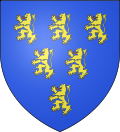
.svg.png)
.svg.png)
.svg.png)
